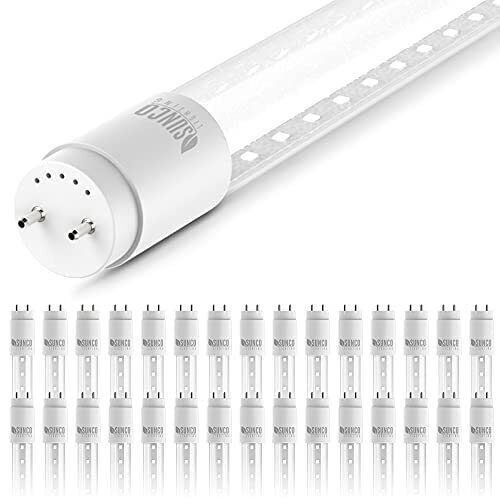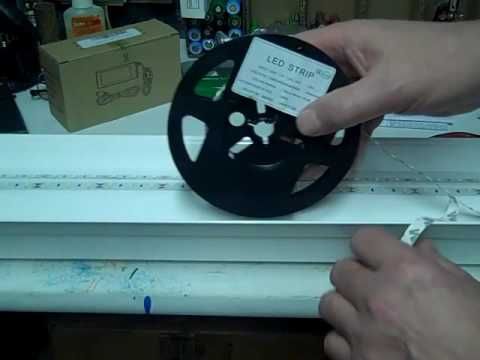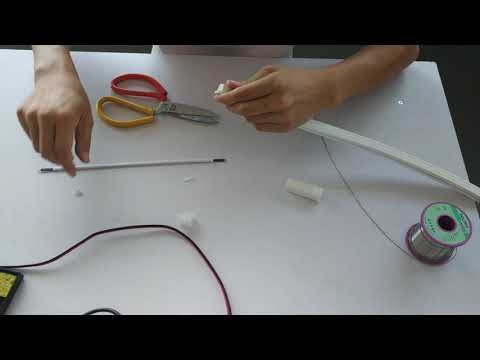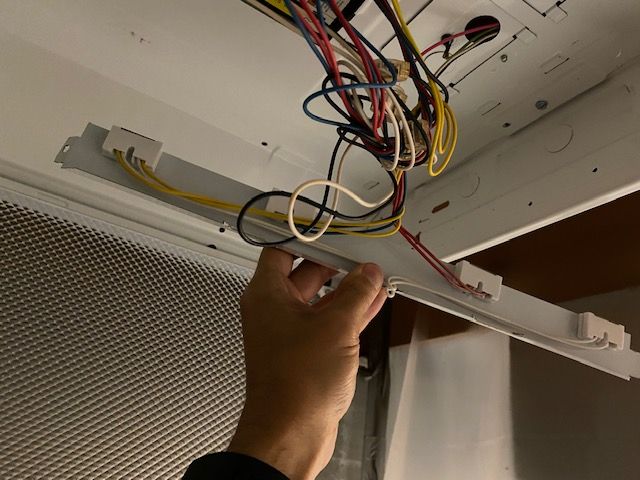In the ever-evolving world of the rapidly changing landscape of lighting technology, the shift towards energy-efficient solutions has become imperative. One such transformation that homeowners and businesses are increasingly adopting is converting 4ft fluorescent lights to LED.
Welcome to our comprehensive guide on “How to Convert 4ft Fluorescent Light to LED.” If you find yourself contemplating an upgrade to a more energy-efficient and cost-effective lighting solution, you’ve come to the right place.
In this guide, we’ll navigate the intricacies of the conversion process, providing you with a step-by-step journey towards transforming your 4ft fluorescent lights into the brilliance of LED technology.

How do 4ft Fluorescent Lights Work?
4ft fluorescent lights operate based on a technology that involves the excitation of gasses and the subsequent emission of light. Here’s a breakdown of how these lights work:
- Gas Excitation: Within the glass tube of the fluorescent light, there is a small amount of mercury vapor. When an electrical current flows through the gas, it ionizes the mercury vapor, creating ultraviolet (UV) light.
- UV Light Production: The ionized mercury atoms emit UV light, which is invisible to the human eye. This UV light interacts with the phosphor coating on the interior surface of the glass tube, causing it to fluoresce.
- Visible Light Emission: The UV radiation is converted to visible light by the phosphor coating, creating the illumination we see. The color of the emitted light is determined by the specific phosphor coating used, allowing for a range of color temperatures.
This process is more energy-efficient than traditional incandescent light bulbs, but it still involves the use of mercury and has a finite lifespan. As we delve into the benefits of converting to LED lights, it’s essential to understand this foundational aspect of fluorescent lighting technology.
Reasons to Convert to LED
Cost Savings
LED lights are renowned for their energy efficiency, leading to substantial cost savings in the long run. The reduced energy consumption translates into lower electricity bills, making them a financially prudent choice for both residential and commercial applications.
Environmental Impact
Converting to LED lighting aligns with environmental sustainability. LEDs have a significantly lower carbon footprint compared to traditional lighting technologies, contributing to efforts aimed at reducing overall environmental impact.
Durability
LEDs are solid-state lights, making them more durable and robust than conventional lighting options. Their resistance to shocks, vibrations, and temperature variations ensures a longer lifespan and lower maintenance costs.
Low Heat Emission:
LEDs don’t produce much heat compared to traditional bulbs, making them safer to touch and reducing the risk of fire hazards. This characteristic is especially valuable in applications where heat-sensitive items are present.
No Harmful Substances
LEDs contain no hazardous materials such as mercury, contributing to a safer and more environmentally friendly lighting solution. This absence of harmful substances makes disposal easier and lessens the impact on ecosystems.
In conclusion, the reasons to convert to LED lighting extend beyond just energy efficiency. With economic benefits, positive environmental contributions, and a range of practical features, making the switch to LED lights is a wise and forward-thinking decision.
Step-by-Step Guide to Convert 4ft Fluorescent Lights to LED
Embarking on the journey to convert your 4ft fluorescent lights to energy-efficient LED technology is a transformative process. Follow this step-by-step guide for a seamless transition:
Gather Necessary Tools and Materials
Before you start the conversion process, ensure you have all the essential tools and materials. These may include LED retrofit kits, screwdrivers, wire strippers, and any other items specified by the LED kit manufacturer.
Turn Off the Power Supply
Safety is paramount. Locate the circuit breaker and turn off the power supply to the fluorescent lights. Confirm the power is off using a voltage tester to avoid any electrical hazards.
Remove Fluorescent Tubes
Carefully uninstall the existing fluorescent tubes by gently rotating them and then pulling them out of the sockets. Dispose of the old tubes responsibly according to local regulations.
Install LED Retrofit Kit
Select the appropriate LED retrofit kit compatible with your fixture. Follow the manufacturer’s instructions to install the LED retrofit tubes or bulbs into the existing sockets. Ensure a secure fit.
Connect Wires
Use wire strippers to expose the necessary lengths of wire. Connect the wires according to the manufacturer’s guidelines, ensuring proper color-coding and secure connections. This step is crucial for the functionality of the LED lights.
Secure the LED Retrofit Kit
Once the wiring is complete, secure the LED retrofit kit in place. Ensure the fixtures are stable and properly aligned. Some retrofit kits may come with clips or brackets for secure attachment.
Restore Power Supply
With the LED retrofit kit securely in place, turn the power supply back on at the circuit breaker. Test the newly installed LED lights to ensure they illuminate properly. If successful, your conversion is complete.
By following these step-by-step instructions, you can successfully convert your 4ft fluorescent lights to energy-efficient LED lighting. This not only enhances energy efficiency but also contributes to long-term cost savings and a more sustainable lighting solution.



As you embark on the journey of converting your 4ft fluorescent lights to LED, it’s essential to be aware of potential issues that may arise. Here’s a guide to troubleshooting common problems during or after the conversion process:
Flickering Lights
Possible Causes
- Incompatible dimmer switch: If you’re using dimmable LED bulbs, ensure your dimmer switch is compatible with LED technology.
- Loose wiring: Check for any loose or improperly connected wires in the fixture.
Troubleshooting Steps
- Replace the dimmer switch with an LED-compatible one if necessary.
- Inspect and re-tighten any loose wiring connections.
Inadequate Brightness
Possible Causes
- Incorrect wattage: Ensure that the LED bulbs you’ve installed match the wattage recommendations for your fixture.
- Poor-quality bulbs: Low-quality LED bulbs may not provide optimal brightness.
Troubleshooting Steps
- Verify the recommended wattage for your fixture and replace bulbs accordingly.
- Consider using high-quality, reputable LED bulbs for better performance.
Uneven Illumination
Possible Causes
- Incorrect placement of LED bulbs or tubes.
- Poorly secured retrofit kit.
Troubleshooting Steps
- Reposition LED bulbs or tubes to ensure even distribution of light.
- Confirm that the retrofit kit is securely and evenly installed.
Color Inconsistency
Possible Causes
- Variations in LED bulb color temperature.
- Poor-quality or mismatched bulbs.
Troubleshooting Steps
- Purchase LED bulbs with consistent color temperatures.
- Invest in high-quality bulbs from reputable manufacturers.
Buzzing Sounds
Possible Causes
- Compatibility issues with dimmer switches.
- Poorly designed or low-quality LED bulbs.
Troubleshooting Steps
- Replace incompatible dimmer switches with LED-compatible ones.
- Consider upgrading to higher-quality LED bulbs to minimize noise.
Interference with Other Electronics
Possible Causes
- Electromagnetic interference from LED bulbs.
- Proximity to sensitive electronic devices.
Troubleshooting Steps
- Choose LED bulbs labeled as “non-interference” or “EMC compliant.”
- Reposition electronic devices away from LED fixtures.
Fluctuating Power
Possible Cause
- Inconsistent power supply.
- Wiring issues.
Troubleshooting Steps
- Consult with an electrician to address any power supply irregularities.
- Ensure all wiring is correctly connected and secured.
Regularly inspecting your LED lighting setup and promptly addressing these common issues will ensure a smooth transition to energy-efficient lighting, providing you with the full benefits of LED technology.
Maintaining your LED lights ensures they continue to shine brightly and efficiently.
Here are some essential maintenance tips to prolong the lifespan and optimize the performance of your LED lighting setup:
Cleaning
- Regular Dusting: Dust can accumulate on LED bulbs and fixtures, affecting light output. Gently dust the bulbs and fixtures regularly using a soft microfiber cloth
- Periodic Deep Cleaning: For more thorough cleaning, use a damp cloth with a mild cleaning solution. Ensure the lights are switched off and disconnected before cleaning.
Regular Checks
- Inspect for Damage: Periodically inspect LED bulbs and fixtures for any signs of damage, including cracks or discoloration. Replace damaged components promptly to maintain optimal performance.
- Check Wiring Connections: Ensure that all wiring connections are secure and free from corrosion. Loose or damaged wires can impact the functionality of LED lights.
Avoid Overheating
- Provide Adequate Ventilation: LED lights are sensitive to heat. Ensure that fixtures have proper ventilation to dissipate heat effectively. Avoid placing LED bulbs in enclosed fixtures that may trap heat.
Control Voltage Fluctuations
- Use Voltage Stabilizers: In areas prone to voltage fluctuations, Installing voltage stabilizers is something you might consider to protect LED lights from sudden spikes or drops in power.
Replace Faulty Components
- Timely Replacement: If you notice flickering lights or reduced brightness, promptly swap out any defective LED bulbs or components. Timely replacements can prevent further damage and maintain consistent performance.
Cost Considerations and Return on Investment
Converting 4ft fluorescent lights to LED involves initial costs, but the long-term benefits often outweigh the upfront investment. Let’s delve into the cost considerations and the potential return on investment (ROI) associated with transitioning to LED lighting:
1 . Initial Investment
LED Retrofit Kits: The cost of LED upgrade kits or bulbs is an initial expense. Prices may vary based on the quality, brand, and specifications of the chosen LED products.
Installation Costs: If you opt for professional installation, consider these costs as part of the initial investment. DIY installations may reduce this expense but require time and effort.
- Long-Term Savings
Energy Efficiency: LED lights are significantly more energy-efficient than fluorescent lights, leading to reduced electricity consumption. This efficiency translates into lower energy bills over the lifespan of the LED bulbs.
Maintenance Costs: LED lights have a longer lifespan than fluorescent lights, resulting in reduced maintenance costs. Fewer replacements mean less frequent expenditures on new bulbs and fixtures.
- Utility Rebates and Incentives
Local Programs: Check for utility rebates or government incentives for transitioning to energy-efficient lighting. Some regions offer financial incentives to encourage businesses and homeowners to adopt LED technology, helping offset initial costs.
- Environmental Impact
Reduced Carbon Footprint: While not a direct financial consideration, the environmental impact of LED conversion is substantial. Lower energy consumption contributes to a reduced carbon footprint, aligning with sustainability goals.
- Life Cycle Cost Analysis
Comprehensive Evaluation: Conduct a life cycle assessment of costs, considering the total costs over the lifespan of LED lights compared to fluorescent lights. This approach provides a comprehensive view of the financial implications.
- Return on Investment (ROI)
Calculate Savings: Evaluate the potential savings in energy costs and reduced maintenance expenses over time. Divide these savings by the initial investment to calculate the ROI.
Long-Term Benefits: LED conversion often yields a positive ROI over the lifespan of the bulbs, making it a cost-effective and financially prudent decision in the long run .
- Upfront Financing Options
Financing Programs: Some companies offer financing programs for LED conversions, allowing you to spread the initial costs over a defined period. Explore these options to manage upfront expenses more effectively.
- Comparison with Traditional Lighting:
Assess Traditional Costs: Compare the total cost of ownership, including usage of energy and maintenance, between traditional fluorescent lights and LED lights. This comparison highlights the potential financial advantages of LED technology.
- Customized Solutions:
Tailored Approaches: Work with lighting professionals to explore personalized remedies that align with your budget and lighting requirements. They can provide insights into cost-effective strategies while optimizing illumination.
In summary, while the upfront costs of converting to LED lights should be considered, long-term financial reserves, potential incentives, and positive environmental impact often make it a sound financial decision.
As technology advances and energy efficiency becomes a focal point, the return on investment for LED lighting continues to strengthen over time.
Pros of Converting 4ft Fluorescent Lights to LED
1 . Energy Efficiency:
Switching to LED lights brings a significant reduction in energy consumption. LEDs convert a higher percentage of electrical energy into light, reducing energy waste in the form of heat.
This efficiency translates to lower electricity bills and a positive environmental impact.
2 . Longevity and Reduced Maintenance:
LEDs boast an impressive lifespan, often outlasting traditional fluorescent lights by a considerable margin.
This longevity means fewer replacements and less maintenance hassle over time, saving both time and money.
3 . Instant Illumination:
One notable advantage is the instant illumination provided by LED lights.
Unlike fluorescent lights that may take a moment to reach full brightness, LEDs offer immediate and consistent light output, ideal for spaces where instant illumination is crucial.
- Environmental Friendliness:
LEDs contribute to a greener environment. They contain no hazardous materials like mercury, reducing the environmental impact associated with disposal.
The lower energy consumption and longer lifespan further contribute to a more sustainable lighting solution.
5 .Customized Lighting Options:
LED technology offers a diverse range of colors and color temperatures, allowing for customizable lighting solutions.
Whether you prefer warm or cool tones, LEDs provide the flexibility to create the desired ambiance in your space.
Cons of Converting 4ft Fluorescent Lights to LED
1 . Initial Cost
The upfront cost of LED retrofit kits or bulbs can be higher compared to traditional fluorescent lights. While the long-term savings offset this initial investment, it’s an important consideration, especially for those on a tight budget.
2 . Compatibility Issues
Some existing fixtures may not be compatible with LED retrofit kits, requiring additional modifications or replacements. Ensuring compatibility may involve extra effort and potentially higher costs for certain setups.
3 . DIY Challenges
Converting to LED lights may pose challenges for those attempting a do-it-yourself (DIY) installation. While many retrofit kits are designed for easy installation, individuals with limited electrical knowledge may face difficulties ensuring a proper and safe conversion.
4 . Color Consistency
In some cases, achieving consistent color temperatures with LED lights can be challenging. This may lead to variations in lighting hues, impacting the overall aesthetic appeal of the space. Choosing high-quality LED bulbs from reputable manufacturers can mitigate this issue.
5 . Dimmer Compatibility
While many LED lights are dimmable, compatibility issues with existing dimmer switches may arise. Upgrading dimmer switches or opting for dimmable LED bulbs specifically designed for the existing switch may be necessary, adding an extra layer of consideration.
In conclusion, the decision to convert 4ft fluorescent lights to LED involves weighing these pros and cons. While the long-term benefits often outweigh the challenges, careful consideration of factors like budget, compatibility, and installation expertise is essential for a successful transition.
Frequently Asked Questions (FAQs)
Frequently Asked Questions (FAQs) about Converting 4ft Fluorescent Lights to LED:
Q . How much can I expect to save on my energy bills after converting to LED lights?
A: Switching to LED lights can lead to significant energy savings. The exact amount varies based on factors such as usage patterns and local energy rates, but many users experience noticeable reductions in their electricity bills over time.
Q . Are LED retrofit kits compatible with all types of existing fixtures?
A . While LED retrofit kits are designed for compatibility with various fixtures, it’s essential to check the specifics of your existing setup. Some fixtures may require modifications or replacements to ensure a seamless conversion.
Q . Can I install LED lights myself, or do I need professional help?
A . The installation process for LED lights is often straightforward, and many retrofit kits are designed for DIY installation. However, individuals with limited electrical knowledge may prefer professional assistance to ensure a safe and effective conversion.
Q . Will converting to LED lights affect the color consistency of my lighting?
A . Consistent color temperatures are a priority when converting to LED lights. Choosing high-quality LED bulbs from reputable manufacturers can help maintain color consistency and avoid variations in lighting hues.
Q . What should I consider before converting to LED lights if I have an existing dimmer switch?
A . Dimmer compatibility is an important consideration. While many LED lights are dimmable, existing dimmer switches may require upgrading for optimal performance. Choosing dimmable LED bulbs specifically designed for your dimmer switch can also ensure compatibility.
These FAQs provide insights into common considerations and concerns related to converting 4ft fluorescent lights to LED, helping users make informed decisions for a successful transition.
Conclusion
Converting 4ft fluorescent lights to LED emerges as a forward-thinking decision with a multitude of benefits. As outlined in our exploration of this transition, the advantages of LED technology span energy efficiency, longevity, and environmental sustainability.
The energy efficiency of LEDs not only leads to immediate cost savings but also aligns with broader sustainability goals. The extended lifespan of LED lights translates to reduced maintenance, offering a convenient and hassle-free lighting solution. The absence of hazardous materials, such as mercury, makes LED lights environmentally friendly and easier to dispose of responsibly.
However, it’s crucial to approach the conversion process thoughtfully, addressing factors such as fixture compatibility, dimmer switches, and installation expertise. Understanding the pros and cons, exploring customer testimonials, and delving into frequently asked questions can guide individuals and businesses toward a successful and seamless transition.
In conclusion, converting 4ft fluorescent lights to LED is not just a lighting upgrade; it’s a strategic investment in efficiency, longevity, and sustainability. As technology continues to advance and environmental considerations become increasingly crucial, LED lighting stands out as a beacon of innovation, offering a brighter and more sustainable future for illuminated spaces.
As an Amazon Associate I earn from qualifying purchases.